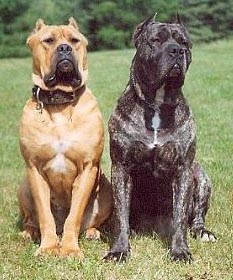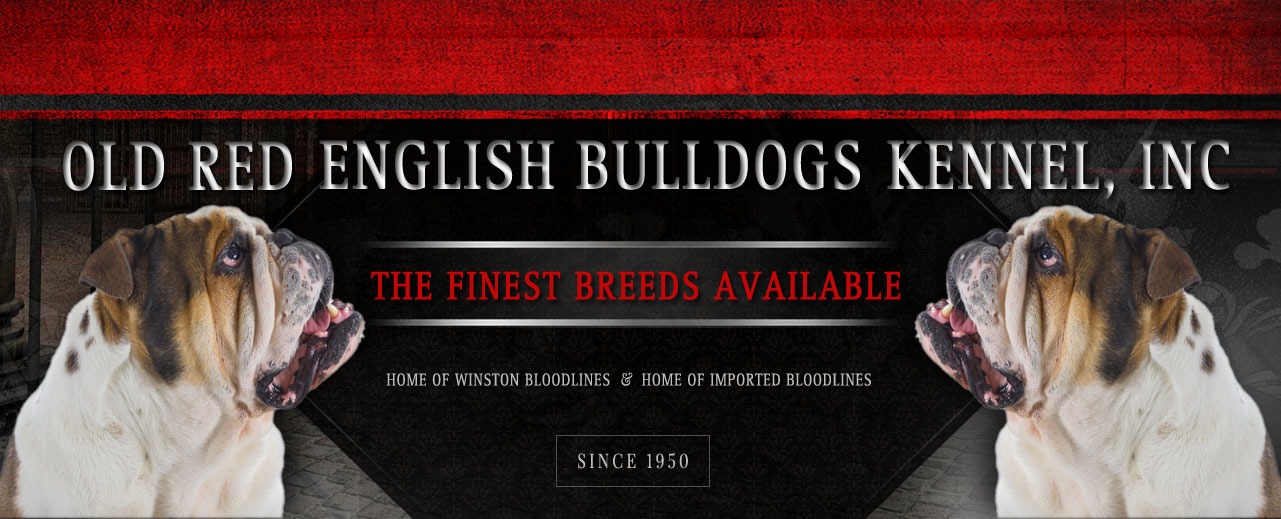
The name Australian Bandogge is a catch-all term for any Bulldog-type Mastiff breed. Boasting prominent muscles and a sturdy frame, the Australian Bandogge Mastiff gives off an athletic and agile appearance. Massive in size, it features a boxy head and a strong jaw. The ears are typically large and should hang down the sides of the head (although some owners choose to crop them). Despite its powerful appearance, the Australian Bandogge Mastiff should have well-balanced proportions and should never appear overweight.
The Australian Bandogge Mastiff has a short, hard-textured coat and a long, tapered tail. In terms of color, its coat is typically brindle or black, but they can also be found in tan, fawn, red, white, and with color patches.
Life Span:10-11 years
Litter Size: 5-10 puppies
Group: Mastiff
Color: Brindle, black, fawn, red and tan. This can be accented with some white and color cow patches.
Hair Length:Short
Size: Large
Shedding: little not that much
Male Height: 25-29 inches (63-73 cm.)
Male Weight: 100 -140 pounds (45-63 kg.)
Female Height: 23.5-26 inches (59-66 cm)
Female Weight: 80-120 pounds (36-54 kg)
Living Area:This breed does best in a home with a large-fenced yard, but can manage an apartment if it is sufficiently exercised.
Coat Description
The Australian Bandogge Mastiff’s coat should be short, close, and of medium-fine texture. It comes in a variety of colors, including brindle, black, tan, fawn, and red, often accented with some white or color patches. However, all-white or predominantly white dogs are not considered desirable. An average shedder, the Australian Bandogge Mastiff’s coat is easy to groom and can be brushed occasionally with a rubber brush to remove dead hair.
The Australian Bandogge Mastiff is not a technically purebred breed. Primarily used for big game hunting and as guard dogs, the Bandogge was employed by British gamekeepers, leading to the breed being referred to as the “Gamekeeper’s Night Dog.” These Australian Bandogges filled the role of patrol companions and dispatch dogs, capturing wounded game. An even more dangerous task for the Gamekeeper’s Night Dog was locating and fighting armed poachers, who would have to fight for their lives if the dog got a hold of them. In France, the Chien du Nuit was a similar type of dog that held the same role as the Australian Bandogge.
The Australian Bandogge Mastiff is a cross of Australian Bulldogs, American Pit Bull Terriers, Bull Mastiffs, Dogue de Bordeaux, and Old English Mastiffs. This breed owes its existence largely to one Australian Bandogge Mastiff breeder, Mr. Kwame Winston. In 1998, veterinarian technician Mr. Winston sought to breed the ultimate guardian dog. His efforts resulted in crossing Australian Bulldogs, American Pit Bull Terriers, Dogue de Bordeaux, Bull Mastiffs, and Old English Mastiffs. Breeder Mr. Kwame Winston was also pivotal in the evolution of this breed, and he specifically refers to his dogs as Australian Bandogge Mastiffs.
Temperament
The Australian Bandogge is described as having an American canine temperament, meaning it has a high stimulus threshold and a pack mentality without a desire to assert rank. When properly raised, this temperament makes them trustworthy with children, often becoming a self-appointed babysitter. Full of spirit when playing and working, the Bandogge is calm, composed, and easygoing during its downtime. It won’t shy away or be apprehensive when meeting other people or dogs and has a high tolerance with a quick recovery from stress.
Good-natured and extremely social, the Australian Bandogge Mastiff is devoted to its owner and eager to work. If raised from a puppy, it will get along with other household pets. As long as you treat the Australian Bandogge Mastiff with respect, it will become a protective, caring, and loving member of your family.
The Australian Bandogge Mastiff will shift from its calm state when a dangerous situation arises, making it an exceptional guard dog and an intruder’s worst nightmare. It won’t bark before it attacks, offering the element of surprise. This breed has an uncanny ability to distinguish between normal human activities and suspicious or aggressive behavior. It has a strong balance of drives and is self-confident, making it a highly predictable and stable dog. The Bandogge can switch between drives with little indication, so it takes an expert and experienced dog handler to discern the switch before it happens. However, don’t be put off — this breed’s drives don’t foster outward aggression, but it’s important to be cautious about this dog’s capabilities when threatened.
As a puppy, the Australian Bandogge Mastiff can be rambunctious, which is often linked to the maturation rate of larger breeds, as well as its environment and upbringing. This dog is recommended for experienced owners who can mold and nurture it according to its individual traits and behaviors.
Health Problems
Like purebred dogs, hybrid dogs such as the Australian Bandogge Mastiff can develop genetic health issues. Australian Bandogge Mastiffs may experience health conditions common to Australian Bulldogs, American Pit Bull Terriers, Dogue de Bordeaux, Bull Mastiffs, and Old English Mastiffs, so it’s important to research breeders thoroughly. Common health concerns include hip and elbow dysplasia, eye diseases (such as progressive retinal atrophy), autoimmune thyroiditis, epilepsy, various types of cancer, and skin problems. Additionally, due to its deep chest, the Australian Bandogge Mastiff is prone to gastric dilatation volvulus, also known as gastric torsion or bloat.
Although there are no guarantees regarding your Australian Bandogge Mastiff’s health, it helps to select a breeder who has conducted health testing to ensure their puppies don’t carry the genetic diseases common to Australian Bulldogs, American Pit Bull Terriers, Dogue de Bordeaux, Bull Mastiffs, and Old English Mastiffs breeds.
Grooming
Grooming an Australian Bandogge Mastiff is fairly easy, as it is a short-haired breed. It’s a good idea to train your puppy to stand still for brushing and grooming. Not only is it a great way to bond, but it will also be easier for you when your dog weighs over 100 pounds. At first, your puppy may not like being groomed. Be patient — with a little kindness, your dog will soon enjoy the practice, as long as you remain calm and consistent. Start by brushing your puppy for a few minutes each day for the first week or two, then gradually increase the time spent grooming. Be sure to brush your Australian Bandogge Mastiff regularly to remove dandruff, dead hair, and dust. Regular brushing reduces shedding, prevents skin infections, and helps with that unpleasant doggy smell.
Exercise
The Australian Bandogge Mastiff requires moderate exercise, but if you don’t provide enough mental and physical stimulation, your dog may become upset when left alone, difficult to control, and destructive. Additionally, if the Bandogge doesn’t get enough exercise, it can become quite lazy. This breed typically needs about 45 minutes of exercise each day to stay healthy and happy.
Although it is a larger dog, the Australian Bandogge Mastiff can do well in apartments if exercised properly. The ideal living situation for this breed is a home with a large, fenced yard. While this dog enjoys its daily outdoor walks, it should not live outdoors full-time — it needs to be indoors with its owner.
Training
Even though the Australian Bandogge Mastiff is an extremely intelligent dog and trains easily, it requires an experienced owner, so this breed is not recommended for first-time dog owners.
When training your Australian Bandogge Mastiff, it is important to establish yourself as the pack leader. If you do not take control, expect significant damage to your home and yard. Since this breed enjoys being active, you’ll need to provide opportunities for exercise throughout the day. When training, be firm and consistent — this is the best way to ensure the breed becomes obedient.
The Australian Bandogge Mastiff is an attentive breed and will quickly pick up on your commands. Once you establish your role as the master of the pack, you’ll have an easier time training this breed.

